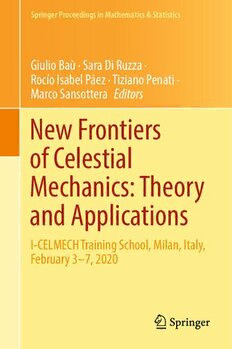
New Frontiers of Celestial Mechanics: Theory and Applications: I-CELMECH Training School, Milan, Italy, February 3–7, 2020 PDF
Preview New Frontiers of Celestial Mechanics: Theory and Applications: I-CELMECH Training School, Milan, Italy, February 3–7, 2020
Springer Proceedings in Mathematics & Statistics Giulio Baù · Sara Di Ruzza · Rocío Isabel Páez · Tiziano Penati · Marco Sansottera Editors New Frontiers of Celestial Mechanics: Theory and Applications I-CELMECH Training School, Milan, Italy, February 3–7, 2020 Springer Proceedings in Mathematics & Statistics Volume 399 This book series features volumes composed of selected contributions from workshops and conferences in all areas of current research in mathematics and statistics,includingdatascience,operationsresearchandoptimization.Inaddition to an overall evaluation of the interest, scientific quality, and timeliness of each proposalatthehandsofthepublisher,individualcontributionsareallrefereedtothe highqualitystandardsofleadingjournalsinthefield.Thus,thisseriesprovidesthe researchcommunitywithwell-edited,authoritativereportsondevelopmentsinthe mostexcitingareasofmathematicalandstatisticalresearchtoday. · · · Giulio Baù Sara Di Ruzza Rocío Isabel Páez · Tiziano Penati Marco Sansottera Editors New Frontiers of Celestial Mechanics: Theory and Applications I-CELMECH Training School, Milan, Italy, February 3–7, 2020 Editors GiulioBaù SaraDiRuzza DepartmentofMathematics DepartmentofMathematics UniversityofPisa UniversityofPalermo Pisa,Italy Palermo,Italy RocíoIsabelPáez TizianoPenati SchoolofComputerScience DepartmentofMathematics andInformationTechnology UniversityofMilan UniversityCollegeCorkUCC Milan,Italy Cork,Ireland MarcoSansottera DepartmentofMathematics UniversityofMilan Milan,Italy ISSN 2194-1009 ISSN 2194-1017 (electronic) SpringerProceedingsinMathematics&Statistics ISBN 978-3-031-13114-1 ISBN 978-3-031-13115-8 (eBook) https://doi.org/10.1007/978-3-031-13115-8 MathematicsSubjectClassification:70F15,37N05,37J40 ©TheEditor(s)(ifapplicable)andTheAuthor(s),underexclusivelicensetoSpringerNature SwitzerlandAG2022 Thisworkissubjecttocopyright.AllrightsaresolelyandexclusivelylicensedbythePublisher,whether thewholeorpartofthematerialisconcerned,specificallytherightsoftranslation,reprinting,reuse ofillustrations,recitation,broadcasting,reproductiononmicrofilmsorinanyotherphysicalway,and transmissionorinformationstorageandretrieval,electronicadaptation,computersoftware,orbysimilar ordissimilarmethodologynowknownorhereafterdeveloped. Theuseofgeneraldescriptivenames,registerednames,trademarks,servicemarks,etc.inthispublication doesnotimply,evenintheabsenceofaspecificstatement,thatsuchnamesareexemptfromtherelevant protectivelawsandregulationsandthereforefreeforgeneraluse. Thepublisher,theauthors,andtheeditorsaresafetoassumethattheadviceandinformationinthisbook arebelievedtobetrueandaccurateatthedateofpublication.Neitherthepublishernortheauthorsor theeditorsgiveawarranty,expressedorimplied,withrespecttothematerialcontainedhereinorforany errorsoromissionsthatmayhavebeenmade.Thepublisherremainsneutralwithregardtojurisdictional claimsinpublishedmapsandinstitutionalaffiliations. ThisSpringerimprintispublishedbytheregisteredcompanySpringerNatureSwitzerlandAG Theregisteredcompanyaddressis:Gewerbestrasse11,6330Cham,Switzerland Preface This volume contains the detailed text of the major lectures delivered during the I-CELMECH Training School 2020 held in Milan, whose aim was to present a contemporary review of recent results in the field of Celestial Mechanics, with specialemphasisontheoreticalaspects.Infact,themoderndevelopmentsofCelestial MechanicshavetheirrootsinthemathematicsofHamiltonianperturbationtheory andofthedynamicalsystems.Itisremarkablehowinthelastdecades,inparallelto thecelebratedtheoremsofthesedisciplines,constructivemethodshavebeendevel- opedinordertotackleproblemswithalongtradition,suchasthestabilityoftheSolar System,therotationsofcelestialbodiesandorbitdetermination,aswellasthenovel scientificneedsraisedbythediscoveryofexoplanetarysystems,themanagementof thespacedebrisproblemandthemodernspacemissiondesign. CelestialMechanicstrainingschoolshaveagreattraditionthatdatesbackto1981 withtheschooloftheNATOAdvancedStudyInstituteheldatCortinad’Ampezzo and that is still going on with the recent summer school SDSM 2017 “Satellite Dynamics and Space Missions:Theory and Applications of Celestial Mechanics”, heldinSanMartinoalCimino. QuotingtheprefaceoftheProceedingsoftrainingschoolinCortinad’Ampezzo in1981,whereitallbegan,theEditorsoftheProceedingswereextremelyfortunate tohaveobtainedthecooperationofoutstandinglecturerswhowereclear,thorough, understandable, patient to answer questions, but above all, had knowledge of the most recent developments in our field of interest. This demonstrates a continuity oftraditioninour community of which weareextremely proud. This preface will brieflyreviewthecontentofthelectures. ThecontributionbyUgoLocatellifocusesontheexplicitconstructionofinvariant toriexploitingsuitableHamiltoniannormalforms,withparticularemphasisonappli- cations to Celestial Mechanics. First, the algorithm constructing the Kolmogorov normalformisdescribedindetail.Thentheextensiontolower-dimensionalelliptic toriisprovided.Bothalgorithmsarethencombinedsoastoaccuratelyapproximate thelong-termdynamicsoftheHD4732extrasolarsystem. v vi Preface ThecontributionbyGabriellaPinzaripresentsareviewofsomeresultsoftheir researchgroup,regardingtherelationbetweensomeparticularmotionsoftheThree- Bodyproblem(3BP)andthemotionsoftheso-calledEuler(ortwo-centre)problem, whichisintegrable.Fortheanalysisofsuchrelation,theauthorsmakeuseoftwo novelresults:ononehand,thetwo-centreproblem(2CP)bearsaremarkableprop- erty,herecalledrenormalizableintegrability,whichstatesthatthesimpleaveraged potentialofthe2CPandtheEulerintegralareonefunctionoftheother;ontheother hand,themotionsoftheEulerintegralareatleastqualitativelyexplicit,andtheaver- agedNewtonianpotentialisaprominentpartofthe3BPHamiltonian.Inprevious works,theauthorsgivepartialanswerstothequestionwhetherthemotionsofthe Eulerintegralcanbetracedinthe3BP,hererevisited. ThecontributionbyAlessandraCellettidealswithdissipativesystems,akeytopic inCelestialMechanics.Inparticulartheproblemoftheexistenceofinvarianttorifor conformallysymplecticsystems,whichhavethepropertytotransformthesymplectic form into a multiple of itself, is studied. Two different models are presented: a discretesystemknownasthestandardmapandacontinuoussystemknownasthe spin-orbit problem. In both cases, both the conservative and dissipative versions are considered, in order to highlight the differences between the symplectic and conformally symplectic dynamics. Finally, a short survey of the present state of KAM (Kolmogorov-Arnold-Moser) estimates for the existence of invariant tori in theconservativeanddissipativestandardmapsandspin-orbitproblemsisprovided. Thecontribution byGwenaël Bouéprovides basictoolstounderstand therota- tional dynamics of extended bodies which could be either rigid or deformable by tides.TheproblemisdescribedinaLagrangianformalismasitwasdeveloped by H.Poincaréin1901.Thecaseofrigidbodyisalsopresentedinthecorresponding Hamiltonian formalism. The mathematical description of the deformation of the extended body follows the approach used by C. Ragazzo and L. Ruiz in their two papersof2015,2017duetothecompactnessandclarityoftheirformalism.Inthis Chapter, many applications to the rotation and the libration of celestial bodies are illustrated. ThecontributionbyChristosEfthymiopoulosconcernsthephenomenonofArnold diffusion.TheauthorsbeginwiththefamousexamplegivenbyArnoldtodescribethe slowdiffusiontakingplaceintheaction-spaceinHamiltoniannonlineardynamical systemswiththreeormoredegreesoffreedom.Thetextintroducesbasicconcepts related to our current understanding of the mechanisms leading to Arnold diffu- sionandatthesametimeperformedaqualitativeinvestigationofthephenomenon of Arnold diffusion with many examples. The problem of the speed of diffusion is investigated using methods of perturbation theory, with particular emphasis on Nekhoroshev’s theorem. The choice of the authors of mixing the analytical and numericalpartstryingtoexplaininaveryrigorouswaynumericalresultsmakesthe paperself-consistent. ThecontributionbyGiovanniF.Gronchidealswiththeproblemofinitialorbit determination of a solar system body, i.e. the determination of a preliminary orbit fromobservations collected forexample byatelescope. Thetwomethods thatare presented,namedLink2andLink3,trytolinktogethertwoandthree,respectively, Preface vii short arcs of optical observations of the same object which can possibly be quite far apart in time. The conservation laws of Kepler’s problem are used to derive a polynomial equation of degree 9 (Link2) and 8 (Link3) for the distance of the bodyfromtheobserver.Somenumericalexamplesshowtheperformanceofthetwo linkagemethodswhentheyareappliedtorealobservationsofasteroids. The contribution by Catalin Gales provides an overview of some recent devel- opments in the study of dynamics of space debris with focus on specific resonant interactions,inparticularthoserelatedtothetesseralresonances.Afteranhistorical introduction to the topic, the authors provide a long-term picture of the dynamics that can help in the modeling and mitigation of the space debris problem, both in termofCartesiancoordinatesandintheHamiltonianframework.Somekeytermsin theperturbingfunctionsareclassified,whiletheeffectofthedissipativeforceofthe atmosphericdragisalsoformulated.Inthefollowingsections,theauthorsdescribe theeffectsofthetesseralresonancesintheLEO,MEOandGEOregions.Finally, theeffectoflunisolarresonancesinhigh-altitudeorbitsandfutureperspectivesare discussed. ThecontributionbyAntonioGiorgilliprovidesananswertoasimplequestion, howdidKeplerdiscoverhiscelebratedlaws?.Theanswerhoweverisnotthatsimple and the present paper guides the reader by a short walk along the main works of Kepler, notably the Astronomia Nova, trying to follow his search of the perfection of the World till the discovery of his celebrated laws. At the end of the road, the consciousnessthatthefinishlinehadnotyetbeenreached. TheI-CELMECHTrainingSchoolwasattendedby86participantsfromallover the world and it was made possible, thanks to the support of project MIUR-PRIN 20178CJA2B“NewfrontiersofCelestialMechanics:theoryandapplications”,the Department of Mathematics “Federigo Enriques” of the Università degli Studi di MilanoandtheMusAB“MuseoAstronomicodiBrera”. Pisa,Italy GiulioBaù Palermo,Italy SaraDiRuzza Cork,Ireland RocíoIsabelPáez Milan,Italy TizianoPenati Milan,Italy MarcoSansottera Contents InvariantKAMTori:FromTheorytoApplicationstoExoplanetary Systems ........................................................... 1 UgoLocatelli,ChiaraCaracciolo,MarcoSansotteraandMaraVolpi ANewAnalysisoftheThree-BodyProblem .......................... 47 JérômeDaquin,SaraDiRuzzaandGabriellaPinzari KAMTheoryforSomeDissipativeSystems .......................... 81 RenatoCalleja,AlessandraCellettiandRafaeldelaLlave TidalEffectsandRotationofExtendedBodies ....................... 123 GwenaëlBoué ArnoldDiffusionandNekhoroshevTheory .......................... 163 ChristosEfthymiopoulosandRocíoIsabelPaez OrbitDeterminationwiththeKeplerianIntegrals .................... 209 GiovanniFedericoGronchi ResonantDynamicsofSpaceDebris ................................. 239 AlessandraCellettiandCatalinGales¸ TheUnaccomplishedPerfectionofKepler’sWorld ................... 269 AntonioGiorgilli ix About the Editors GiulioBaùisAssociateProfessorattheDepartmentofMathematicsoftheUniver- sity of Pisa. His research activity deals with the development of new orbit propa- gationanddeterminationmethodsforsmallcelestialbodies(inparticularasteroids andspacedebris),thestudyoftheirdynamics,andregularizationtechniquesinthe N-bodyproblem. SaraDiRuzzaisaResearcherofMathematicalPhysicsattheDepartmentofMathe- maticsattheUniversityofPalermo.HermainfieldofinterestisCelestialMechanics. She worked on the spin-orbit problem, on some particular cases of the three-body problem both from an analytical and numerical point of view. She applied theory torealscenariossuchasasteroidsmotionandspacemissions.Thelatestworksare focusedontheoccurrenceofchaosintheplanarthree-bodyproblem. Rocío Isabel Páez is a Senior Postdoctoral Researcher at the University College Cork, in Ireland. She received her Ph.D. in Mathematics from the University of Rome “Tor Vergata” in 2016. Since then, she has held academic positions at the University of Rome “Tor Vergata”, the Academy of Athens, and the University of Padova.HerresearchareaisinAppliedMathematics,withafocusontheapplication ofadvancedmethodsofperturbationtheoryandnumericalsimulationsinDynamical Astronomy. TizianoPenatiisAssociateProfessorofMathematicalPhysicsattheDepartmentof Mathematics,UniversityofMilan.HismainfieldofinterestisHamiltonianPerturba- tionTheory,withspecialattentiontoNormalFormtechniques.Hisworkfocuseson theinvestigationoftime-periodiclocalizedstructuresandmetastabilityphenomena in Hamiltonian Lattices, like the Fermi–Pasta–Ulam–Tsingou, the discrete Klein– Gordon,orthediscreteNonlinearSchroedingermodels. xi
